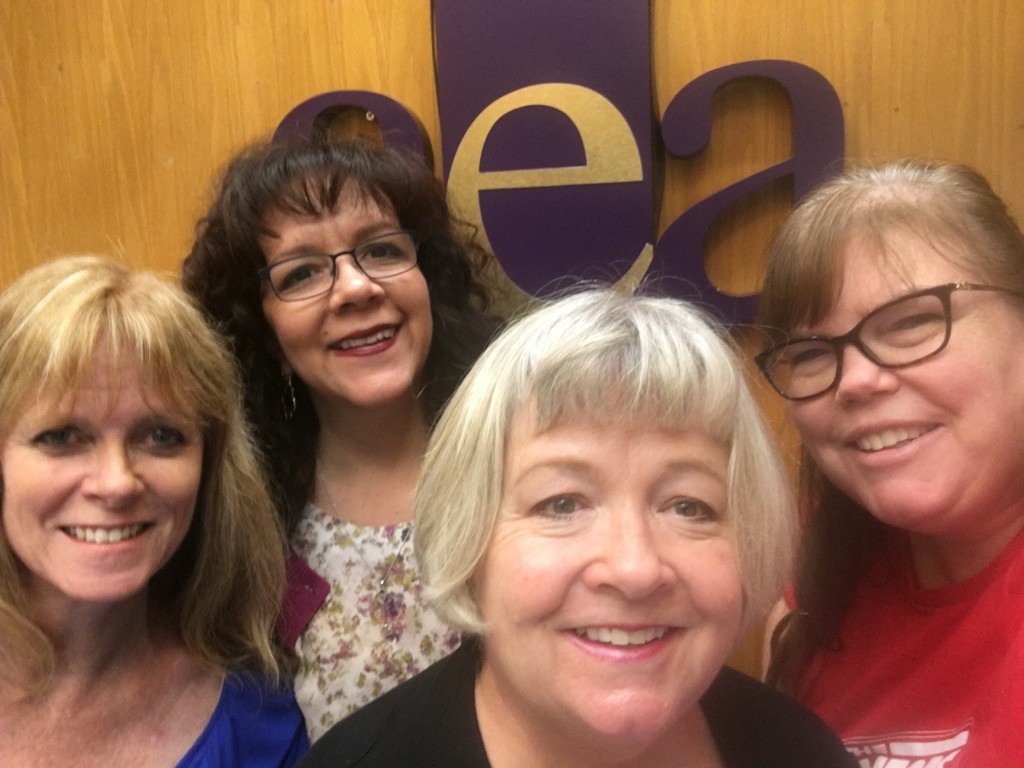Last spring, when 70,000 teachers flooded the Capitol to make five demands known, there were as many leaders as followers.
Educators flexed the bullhorn, organized a band, wrote initiatives, arranged meetings with lawmakers, trained people to circulate petitions, set up tents with shade and water for their colleagues, texted relentlessly, recorded live video, made the best-crafted protest signs you ever saw, designed t-shirts and stickers, and marched.
For some, this leadership was in their blood by this point. They may have grown up in families of activists, or come from states where actual teacher strikes happen. Some had already been active in the Arizona Education Association or other political groups. Some had been department chairs, or had administrative certificates bursting in their files.
For many, though, this was the first time they had taken on what they recognized as a leadership role. Most had never done anything so… what is the best word? Massive? Pronounced? Rebellious? Revolutionary? Transformational? Who would have known at the beginning that we would have been headed toward a six day walkout from our classrooms? This was not something that most people anticipated or savored. Facebook groups helped these teacher leaders sort out their thoughts, values and beliefs, and helped communicate logistics, but where did this massive wave of teacher leadership come from?
Much of the wave has continued through to the election Tuesday, as teachers organized canvasses, worked on campaigns, and even ran for office.
Will the wave roll on? Or crash upon the shore of election day, for better or worse?
This weekend, I began working with a group of teachers that will have the opportunity to strategize around this issue, or really any issue they choose. We began the 2018-19 NEA Teacher Leadership Institute with our Arizona cohort. I am one of three coaches, along with Heather Robinson, and our leader RosaMaria Cordova, both NBCT’s. Nell Pederson, AEA staff, will support the work and coordinate the association side of things, keeping us connected to the national effort.

AZ TLI Team Left to Right: Heather Robinson, NBCT; RosaMaria Cordova, NBCT, Nell Pederson of AEA; Amethyst Hinton Sainz, NBCT
Several of the new fellows this year are teachers who led important aspects of the Red for Ed movement. They will come to our program seasoned by what Nell refers to as our “professional development down at the Capitol.” It is intriguing to think about what it will mean to coach a group of teachers many of whom are already powerhouses in their own right.
As I think about how we will help this group move forward, I keep coming back to the power of reflection. Although #RedforEd, #InvestinEd and #EdWave have accomplished much in the past several months, not every battle has been won, not even close. And I can recall many rocky moments when online discussions and debates threatened to derail momentum, and yet there was always an attempt to re-assess the situation and allow new ideas to provide answers.
The main tool we will use to reflect is Teacher Leadership Competencies. Developed by through a partnership among the Center for Teaching Quality, NEA and the National Board of Professional Teaching Standards, they provide a simple yet powerful matrix that any teacher can use to evaluate herself as a leader.
The competencies are not a checklist or a how-to manual by any means, and I appreciate that. Our fellows will come to us with a wealth of experiences, accomplishments, goals and ideas when it comes to teacher leadership. They may even have doubts, fears or insecurities. The competencies will give them a language with which to discuss, reflect on and strengthen their own abilities, within the contexts of their work and goals for their capstone project.
Will the #EdWave continue to roll? I believe it will, and it will deepen in its capacity, powered by the opportunities all of us take to reflect on where we are, how we got here, and where we need to be next.










Comments 4
Great post! Wishing you and the cohort the very best as you determine goals and action steps. I love the Teacher Leadership Competencies. We used them a lot as the AZ Hope Street Fellows. I wish that district teacher evaluations included competencies about teacher leadership. Have you seen the AZ K12 Center Professional Learning Plan kit? It has some great reflective tools for goal setting, documenting growth, and reflecting on the journey. They’re about $15. I hadn’t seen them until Hope Street Group, but really enjoyed using it. Hoping my school campus uses them for all teachers next year
I saw that there WAS a professional learning plan kit, but I haven’t explored it. Our district uses the Danielson framework for evaluations, and the Domain 4 includes a lot of language about teacher leadership, especially at the highest level of the rubric.
But yes, the competencies are so explicit, and that’s what I think really makes them practical for self-reflection and growth. You can see when you move along the continuum, and it’s exciting to know when you are making a difference! It’s also helpful to realize those areas where you need to build your own capacity before you can have an impact. (I know I realized a lot of those when I did the TLI! I am still growing in many areas for sure!)
I love this aspect of Red for Ed. We have seen a huge rise in teachers who identify themselves as leaders. These teachers worked to communicate effectively, hear multiple perspectives, and make decisions based on what they see as best for students and their work with a group. Since Red for Ed, a number of these teachers have gone back to school to start working on becoming administrators. This byproduct of the Red for Ed movement is one that will help schools grow for the next generation.
I have seen relationships develop and movements solidify through my envolvement this past year. Through the #RedforEd movement I am connected with people and information sources previously completely unknown to me. I am seeing myself and others take on the roll and title of teacher leader through our actions and not a job title. It’s so encouraging to be in this fight together!